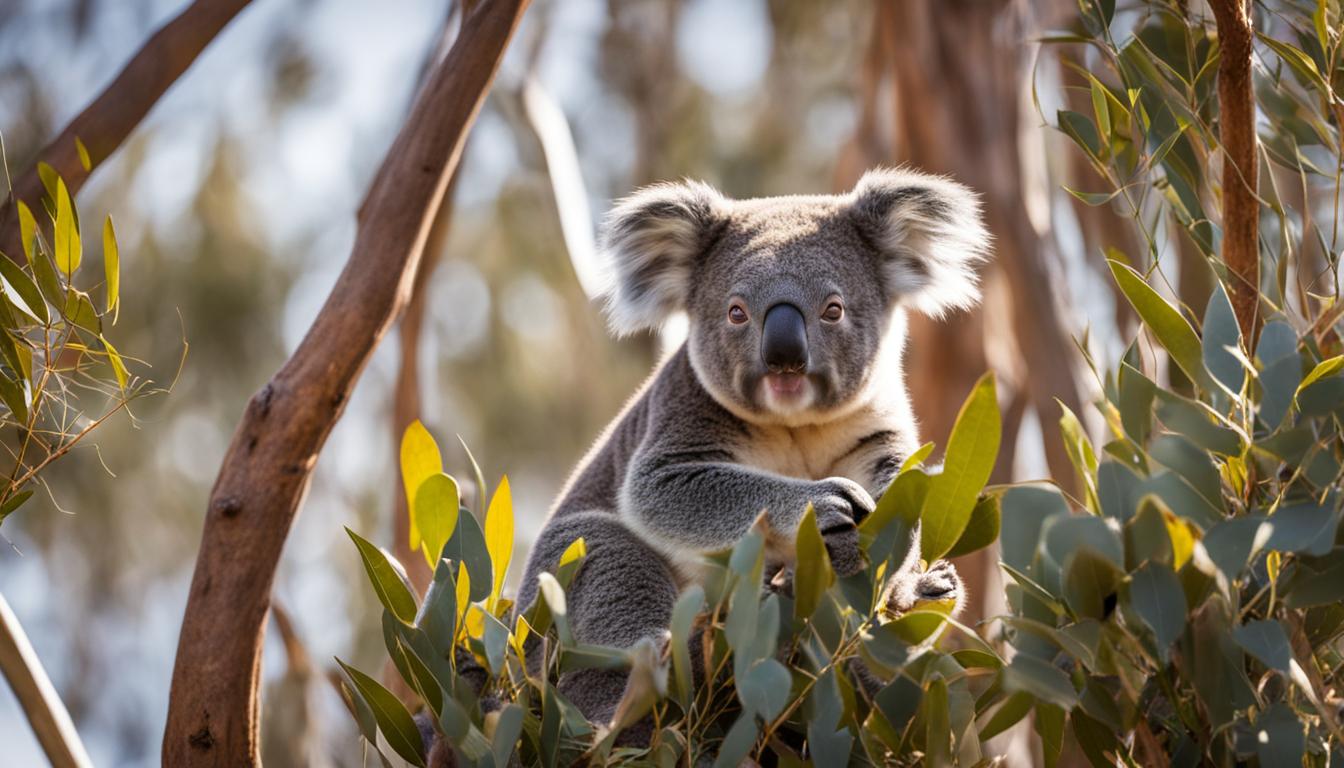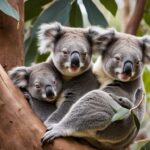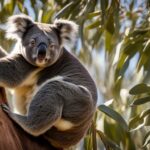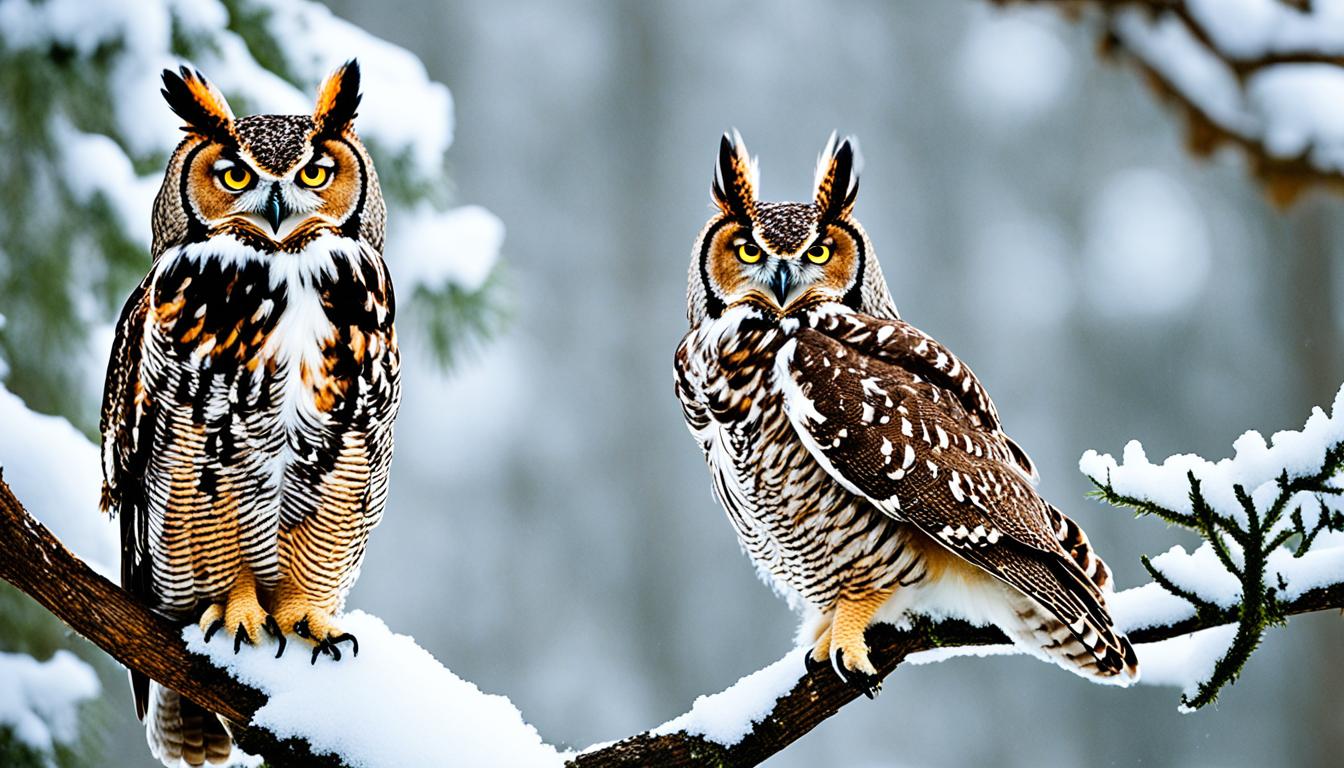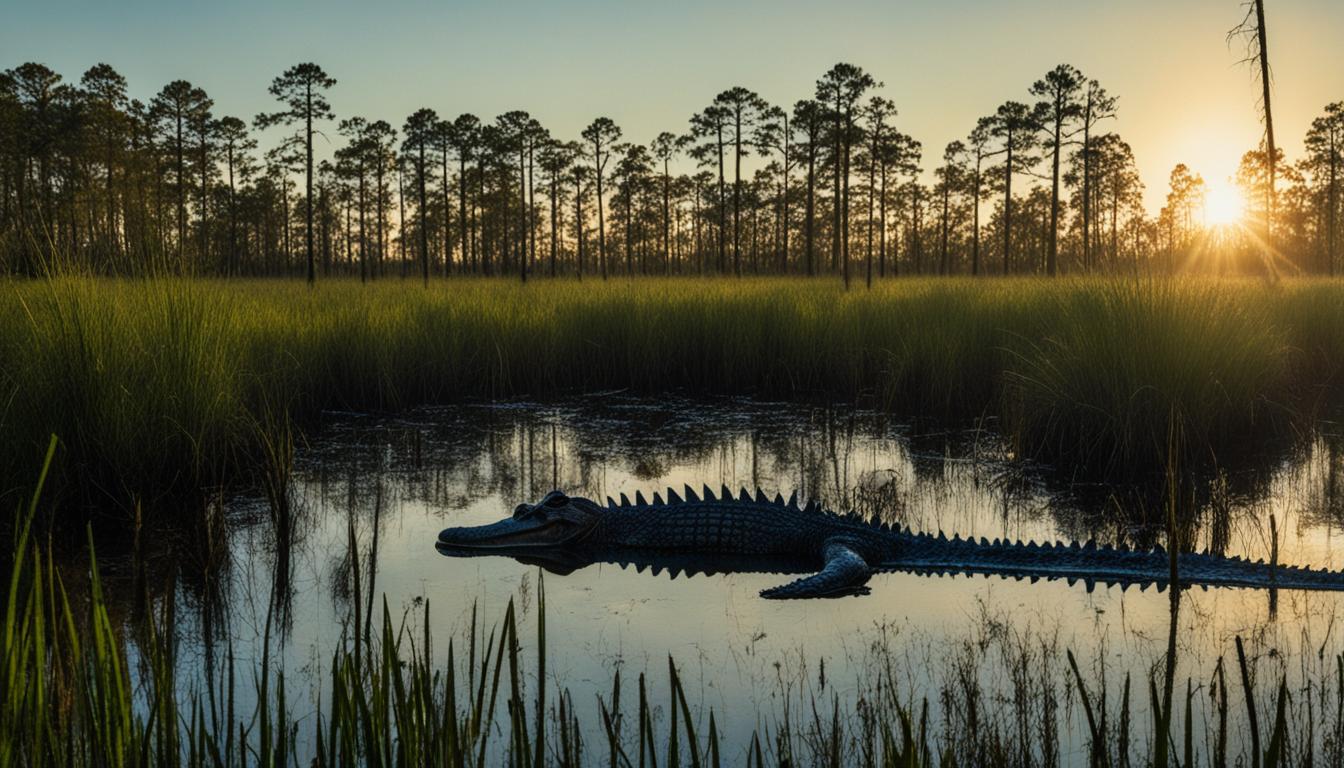Have you ever wondered about the fascinating behavior of koalas? These adorable creatures have unique habits and social interactions both in their natural habitat and in captivity. Understanding their behavior is key to ensuring their well-being and conservation.
Koalas are known for their primarily solitary lifestyle. In the wild, they inhabit forest habitats in Australia, where they spend most of their time alone. However, they do have some social interactions with other koalas, such as mating and marking their territories.
Koala Diet and Feeding Habits
Koalas have a specialized diet consisting almost entirely of eucalyptus leaves. These leaves are low in nutrition, so koalas need to eat a large quantity of them to meet their energy needs. On average, a koala consumes about 500 grams of leaves each day.
It is important to provide koalas with a fresh provision of eucalyptus leaves every day to ensure they have an adequate food source. Koalas typically prefer to eat the tips of the leaves, so offering a variety of eucalyptus species and presenting them in different locations can encourage foraging and exploratory behaviors.
Eucalyptus leaves contain toxic compounds, but koalas have evolved a specialized digestive system to break down these toxins. They acquire the necessary bacteria to digest the leaves from their mother’s excrement when they are young. Additionally, koalas obtain most of their water requirements from the leaves they consume.
Overall, understanding and meeting the dietary needs of koalas is crucial for their well-being. Providing fresh eucalyptus leaves, offering a variety of species, and promoting natural foraging behaviors can help ensure koalas receive the nutrition they require.
Koala Habitat and Behavior in the Wild
Koalas are fascinating creatures that have adapted to a unique lifestyle in their natural habitats. They are most commonly found in open forest and woodland communities, where specific food trees define their home ranges. These solitary animals live within a network of overlapping territories, with males establishing dominance over females’ home ranges during the breeding season. Koalas have a highly developed sense of territorial behavior, marking their boundaries through scent and vocalizations.
Sleeping patterns play a crucial role in the lives of koalas. These adorable creatures can sleep for up to 20 hours a day, often resting in the forks of trees with their limbs folded. They are primarily active at night and during dawn and dusk, when they emerge to feed on eucalyptus leaves. While their eyesight is poor, koalas rely on their acute hearing and sense of smell to navigate their surroundings.
“Koalas have a highly developed sense of territorial behavior, marking their boundaries through scent and vocalizations.”
Koala Social Behavior and Communication
Despite being solitary creatures, koalas still engage in social interactions, particularly during the breeding season. Male koalas use vocalizations and scent marking to attract females and establish their dominance. Females, on the other hand, communicate their receptiveness to mating through vocalizations and scent signals. While they may not exhibit complex social structures like some other animals, koalas have their own unique ways of communication within their population.
| Behavior | Characteristic |
|---|---|
| Territorial Behavior | Koalas mark their boundaries through scent and vocalizations, establishing dominance over certain areas. |
| Sleeping Patterns | Koalas can sleep for up to 20 hours a day and are mostly active at night and during dawn and dusk. |
| Social Behavior | While primarily solitary, koalas engage in social interactions during the breeding season, using vocalizations and scent marking. |
| Communication | Koalas communicate through vocalizations and scent signals to attract mates and establish their receptiveness. |
Understanding the habitat and behavior of koalas in the wild is essential for their conservation and well-being. By preserving their forest habitats and providing suitable conditions in captivity, we can ensure the survival of these iconic Australian animals for generations to come.
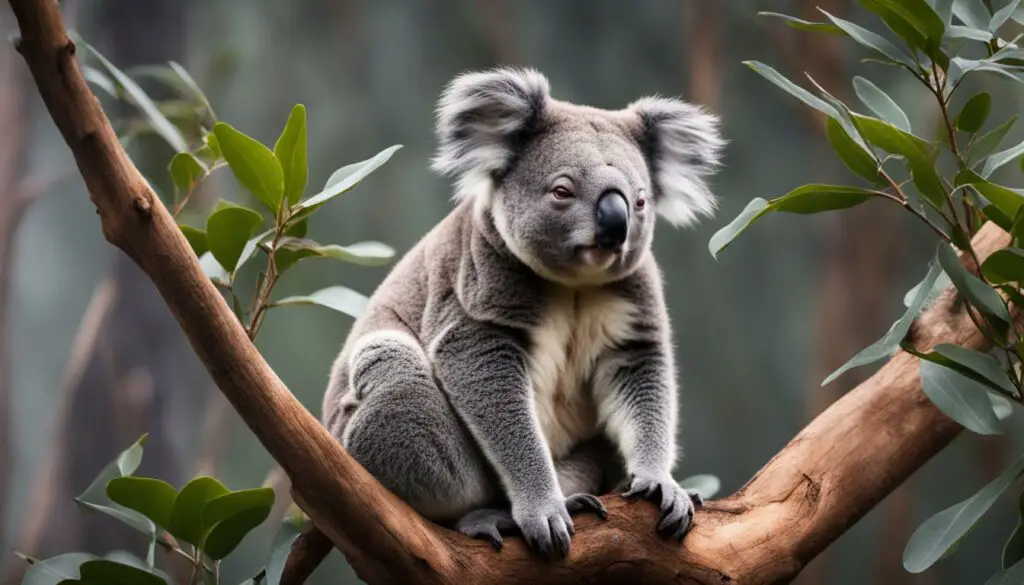
Koala Reproduction and Lifecycle
Koalas have a unique reproductive cycle and lifecycle. Male koalas typically begin mating at around three to four years of age, while females start breeding at two years of age. A female koala gives birth to a single joey after a gestation period of 35 days. The joey is born undeveloped and crawls into its mother’s pouch, where it continues to grow and develop.
Inside the pouch, the joey attaches itself to one of the mother’s teats and remains there for six months. During this time, it receives all its nutrition and protection. After six months, the joey starts to explore the world outside the pouch, riding on its mother’s back. This phase lasts between six and 12 months, during which the joey gradually becomes more independent.
Koalas have a relatively short lifespan of around 10 to 12 years in the wild. However, females can breed until their late teens. It is worth noting that the presence of diseases, such as Chlamydia, can significantly impact the health and life expectancy of koalas, contributing to the decline in their population.
To summarize, the reproductive cycle of koalas involves mating between males and females, followed by the birth of a single joey. The joey spends its early months in the pouch, gradually gaining independence as it grows. As koalas face various challenges and threats to their survival, conservation efforts are crucial to protect their unique reproductive behaviors and ensure their long-term survival.
Table: Koala Reproduction and Lifecycle
| Age | Mating Behavior | Gestation Period | Joey Development | Lifespan |
|---|---|---|---|---|
| Males: 3-4 years Females: 2 years |
Mating begins | 35 days | Born undeveloped, crawls into mother’s pouch | 10-12 years (females can breed until late teens) |
| Note: Presence of diseases like Chlamydia can impact life expectancy and contribute to population decline. | ||||
Koala Appearance and Adaptations
Koalas have a unique and distinctive appearance that sets them apart from other animals. With their large round head, big furry ears, and big black nose, they have a charming and endearing look. Their fur is usually grey-brown in color, providing them with excellent camouflage in their forest habitat. Interestingly, koalas have no fur on their nose or the palms of their paws. This adaptation helps them maintain a better grip on the trees they climb and prevents the buildup of dirt and debris.
This adorable marsupial also possesses strong limbs and sharp claws that are perfectly suited for their arboreal lifestyle. These adaptations enable them to climb and grip onto trees effortlessly. Additionally, koalas have specially designed bottoms with extra padding to allow them to wedge themselves comfortably in tree forks while resting or sleeping. It’s a unique adaptation that helps them conserve energy and remain secure in their chosen spot.
“Koalas have a unique appearance and a set of adaptations that allow them to thrive in their native habitat. Their furry ears, large nose, and distinct coloration make them instantly recognizable. Their strong limbs, sharp claws, and specialized bottoms help them navigate and rest comfortably in trees.”
Another fascinating adaptation of the koala is their postural changes, which are used to regulate their body temperature. On hot days, koalas extend their limbs to maximize their exposure to the breeze, helping them to cool down. Conversely, on cold, wet, and windy days, they fold their arms and legs, reducing their surface area and minimizing heat loss. This remarkable ability to adjust their posture showcases their exceptional adaptability to various environmental conditions.
Vibrant Koala Colors
The beautiful coloration of koalas’ fur not only serves as excellent camouflage but also provides protection against harmful UV rays. A study conducted by researchers at the University of Melbourne found that the fur of koalas contains unique pigments that block ultraviolet (UV) radiation. These pigments are not only effective in blocking UV rays but also give the fur its distinctive grey-brown color. This adaptation helps protect the koalas from the harsh Australian sun, reducing the risk of sunburn and skin cancer.
Koala Appearance Table
| Physical Features | Adaptations |
|---|---|
| Large round head | Aiding in better vision and cognitive function |
| Big furry ears | Enhancing hearing capabilities and thermoregulation |
| Big black nose | Excellent sense of smell and aiding in identification |
| Grey-brown fur | Camouflage and protection against UV rays |
| No fur on nose and palms of paws | Better grip and cleanliness |
| Strong limbs and sharp claws | Efficient climbing and tree gripping abilities |
| Specialized bottom | Comfortable resting and securing in tree forks |
Conclusion
Koalas exhibit fascinating behavior both in the wild and captivity. Their primarily solitary lifestyle and specific habitat requirements make them unique creatures. Understanding and replicating their natural behaviors is crucial for their well-being in captivity, ensuring they have access to suitable environments that promote their natural activities, such as climbing and foraging for eucalyptus leaves.
However, koalas face numerous challenges, including habitat loss, human encroachment, and the prevalence of diseases like Chlamydia, which contribute to the decline in their population. Conservation efforts are essential to protect their behavior and ensure their survival for future generations.
In conclusion, by appreciating and preserving the fascinating behavior of koalas, we can contribute to the overall conservation of this iconic species. Through education, research, and responsible management of their habitats, we can help secure a brighter future for koalas and ensure that their behavior continues to captivate and inspire us.
Source:
www.example.com
Do Koalas Exhibit Different Behaviors in the Wild Compared to in Captivity?
Koalas showcase distinct behaviors in their natural habitat compared to captivity. Interesting facts about koalas show that in the wild, they are more active and agile, spending most of their time climbing trees. In captivity, they exhibit an altered behavior due to limited space, exhibiting more sedentary characteristics.
FAQ
What is the natural behavior of koalas?
Koalas have a primarily solitary lifestyle and are highly territorial. They sleep for long periods of time, mainly eat eucalyptus leaves, and communicate through vocalizations and scent marking.
What do koalas eat?
Koalas primarily eat eucalyptus leaves, consuming around 500 grams per day. They obtain most of their water requirements from the leaves and prefer to eat the tips of the leaves.
Where do koalas live?
Koalas live in forest habitats in Australia, primarily in open forest and woodland communities. Their habitat is defined by the presence of specific food trees.
How do koalas reproduce?
Female koalas give birth to a single joey after a gestation period of 35 days. The young stays in the mother’s pouch for six months before emerging and spends six to 12 months riding on its mother’s back.
What do koalas look like?
Koalas have a large round head, big furry ears, and a big black nose. Their fur is usually grey-brown in color with white fur on certain parts of their body. They have no fur on their nose or the palms of their paws.

